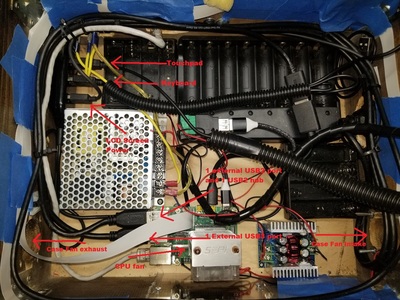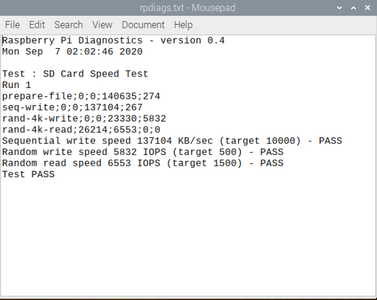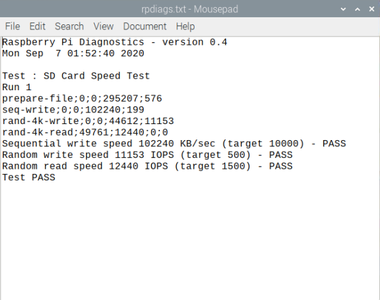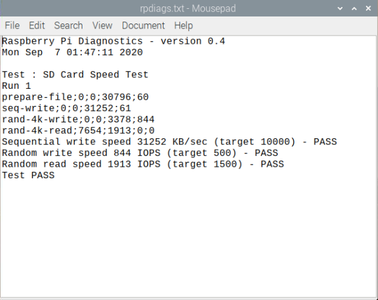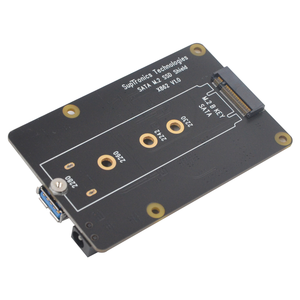I decided to upgrade my Steampunk Laptop. To make it a bit snappier I wanted to upgrade the SD Card to either an M.2 or SSD, so I did the required dance (which has since been made easier thanks to a recent firmware update) to make it bootable via USB, and now the thing boots from the SD Card in a reader plugged into the USB3.0 port
Okay, step one done
Then I tried to create an image onto the SSD drive from the SD Card living in the SD Card socket, but it kept failing with the error "failed to create file system"
I tried various ways of reformatting the SSD, but, always with the same error msg, so I used another Pi4 on the bench to create the clone, but when I plugged it into the Steampunk Pi, it started to boot, then the yellow "low voltage" symbol flashed on the screen for a few seconds, and it went into a bootloop, so, another failure, but, with a clue...
Voltage
I swapped out the power supply for something a bit beefier and turned the voltage up from 5.1 to 5.2 and was able to get the thing to boot to the M.2, but still with the lightening bolt, so I turned it up to 5.3 and the lightening bolt finally went away, but booting to the SSD still gave me the low voltage error, so I finally turned it up to 5.4 and it mostly went away. It still showed up during boot, and flashed occasionally while running, but, I was afraid to turn it up any higher for fear of smoking something
Now, I know it's got quite a few things sucking power away from it, like the 7"LCD screen is probably the biggest culprit, as well as the CPU fan, 2 case fans, then the camera, and, to a lesser degree, the keyboard and touchpad, so it makes sense that I would be getting low voltage errors, but, my question is...
How high do you think it's okay to crank up the voltage before I smoke something ?
This question is only for the AC power supply for now, as the DC/DC converter has a setting for amps as well as voltage, but the AC/DC converter only has one control, which is for voltage
There are probably voltage drops over the wires leading from the psu to the various destinations.
Try using thicker wires for the power leads.
Measure voltage at the consumer ans see how much voltage is dropped by the leads.
hj
Yea... Rats...
Good catch
I changed the wires coming from the PSU to the USB socket, as well as the USB cable from the socket to the Pi, but I forgot the swap out the wires going to the knife switches on the front of the case
Rats !
That means I have to rewire the whole case cover and drill bigger holes
I completely overlooked that... Thanks !
Wow, that's quite the beast you've wired up there Spyder! I counted holders for 16 batteries.
I'm curious, are the voltage measurements you're providing being measured on the Raspberry Pi, or at the output of your power supply?
The Pi does have onboard voltage regulation of course, as it needs to convert that 5-volts into 3.3-volts to power its processor, so it may be able to withstand a bit over 5-volts. Personally I'm like you and am a bit uncomfortable cranking it up too high.
Measure voltage at the consumer ans see how much voltage is dropped by the leads.
That's the solution right there. Between that and your switch rewiring, you'll probably get this working.
😎
Bill
"Never trust a computer you can’t throw out a window." — Steve Wozniak
I counted holders for 16 batteries.
It's actually only 8.
It's set up so that you can use either 4 or 8 cells. The 2 holders for 4 cells each are set up in parallel, with the other thing that looks like 8 being a charger that isn't directly connected to anything. It's just a charger that doesn't supply any power. I just wanted the charger to be inside the unit for convenience sake. This way you can charge 4 batteries while using the other 4, or, switch it over to AC with the knife switches on the front
are the voltage measurements you're providing being measured on the Raspberry Pi, or at the output of your power supply?
The voltage measurements were taken directly from the output of the power supply, not what comes into the actual pi, which I stupidly neglected to even measure at all
This whole problem got noticed because I was trying to replace the SD Card with an SSD drive, but it seems that the SSD takes more power than I had counted on
This is something that I noticed on another Pi I have on the bench, where when I installed the SSD, the range of the wireless kb and mouse went down to about 2 feet. I thought I had broken something (software-wise) til I got the mouse and kb closer to the pi itself. I figured that the SSD must be sucking power away from the USB dongle, leaving it under powered, which is something I had never considered
Now, this test Pi has nothing else connected to it, so the culprit had to be the only new thing I connected... the SSD drive
It seems that the Raspberry Pi 4 uses a 5-volt Zener diode as its voltage protection, it doesn't actually regulate it. So it's likely that increasing the voltage would still be safe for the Pi, until you burn out that diode!
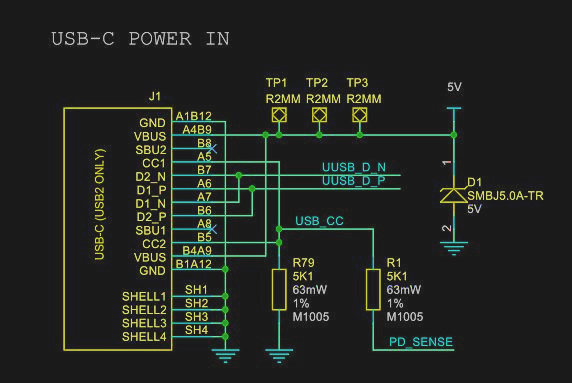
The resistors at the bottom are used to tell the USB-C power supply how much voltage and current to send (and in the original Pi 4's they were used incorrectly!).
Just out of curiosity, what are you using on your bench to power the Pi4 there? Is it a USC-C supply or the official RasPi power supply?
I'm also wondering if you powered the SSD separately, ie. not from the Pi ISB port but from an independent power supply connection, if you'd have better WiFi and BT performance?
BTW, I used to consult at an art school here in Montreal where they trained artists to work for Ubisoft, Warner Brothers, and Electronics Arts making video games, which is a big thing out here. They had a monthly Steampunk drawing party, before working with them I had no idea what Steampunk even was. The mechanical contraptions and electronic accessories they built for their costumes were amazing!
😎
Bill
"Never trust a computer you can’t throw out a window." — Steve Wozniak
it's likely that increasing the voltage would still be safe for the Pi, until you burn out that diode!
I'm also wondering if you powered the SSD separately
I suppose I could split off the power before it gets to the USB socket, add a 3.0 hub, and try to power the SSD from that, so that it wouldn't be taking the power directly from the Pi, but rather stealing it before it gets there. I'm not sure I like the idea of adding any more parts to the inside tho, it's getting kinda cluttered in there as it is
what are you using on your bench to power the Pi4 there? Is it a USC-C supply or the official RasPi power supply?
The one on the bench is the official USB-C Raspberry Pi power supply. The only thing different is that I added that cute little push button switch dongle thing to it for convenience to save wear and tear on the USB-C socket cuz I kept powering it up and down to swap out parts
UPDATE: I tried using a powered 3.0 hub on the bench Pi, and it had very little effect other than removing the lightening bolt from the screen, which was a plus in any case, HOWEVER... you might want to take a peek at this intel white paper on USB3.0 and 2.4ghz interference...
I suspect this could be the reason for the poor wireless KB and mouse issues when using the SSD in the 3.0 port rather than power being at fault on the bench Pi
I ran a few tests on performance vis-a-vis SD Vs SSD Vs M.2 drives that you might find interesting tho...
Here's a 5 year old Vertex Plus R2...
And a brand new SanDisk SSD Plus...
And an M.2 drive...
And finally, a SanDisk Extreme Plus (gold) SD Card...
And I didn't have a mechanical drive that I felt like sacrificing to this experiment, nor did I feel like putting the Pi thru trying to power the thing, so I don't have any data on that, but I thought it was interesting to see how they measured up speed-wise, and as you can see, pretty much anything you do is better than an SD Card.
There was a noticeable performance enhancement just booting the thing up
For my next magic trick, I'm gonna see if I can get Windows 10 onto an SSD drive. It's running now on an SD card. Booting slow, but once it's up and running, it's not all that bad. No sound tho, but not bad. I've already gotten a few programs installed on it that I couldn't get to run on my Win7 desktop, which was impressive
before working with them I had no idea what Steampunk even was.
I used to live in Troy NY, where they used to have a yearly Steampunk Festival, so it was kinda inflicted on me. (For some odd reason, they didn't have it this year) It gave me a few ideas, which is why this laptop ended up being borne. They had so many cool things, I thought... why not try it ?
I don't think I'm going to pattern my life after it, but it was a fun experiment
I swapped out the power wires going in and out of the knife switches, but the problem remains, and I don't think that's the direction that the problem is going to be solved in anyway
I stuck that m.2 drive in another pi4, and it's still getting the low power lightening bolt even with no other parts attached to it so I picked up a nifty m.2 to SATA converter with a mounting board,
which is really cool BTW, and it comes with a really cool USB to USB jumper thing, so I can stack the Pi and the M.2 converter, but, that item gives me the low power problem also. Now, that board has a separate power connector for its own 5V supply, and when I connect that, the lightening bolt goes away, which is fine, but, I can't seem to make the Windows 10 image boot from the M.2, and Berry-Boot doesn't give me any way that I can see to install Windows 10, so, I guess that Steampunk Pi is gonna be stuck with some version of Linux as an OS, which isn't a great loss I guess
Now I need to design some horns for the nifty little 1 inch speakers I bought and it'll have sound


